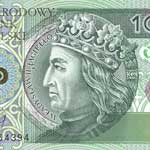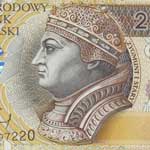Monarchs of Poland: Portraits of the 1994 Banknote Series

The Polish National Bank (Narodowy Bank Polski) created a series of five banknotes for its 1994 paper money series. Though not a fantastically attractive series, this set does have a certain appeal based on coloration and consistency of design, which is based on Polish rulers. This series features five monarchs of Poland on the 10, 20, 50, 100, and 200 Zloty notes (Zloty means "Gold", as in "Gold Ones" in Polish). The following is a brief description and history of the five Dukes and Kings.
 Mieszko I of Poland was the first Christian ruler of Poland, and is considered the de facto creator of the Polish state. According to existing sources, Mieszko I was a wise politician, a talented military leader, and a charismatic ruler. He successfully used diplomacy, concluding alliances, first with Bohemia, then Sweden, and the Holy Roman Empire. In foreign policy, he placed the interests of his country foremost, even entering into agreements with his former enemies. On his death, he left to his sons a country with greatly expanded territories, and a well-established position in Europe. He ruled from approximately 960 to 992.
Mieszko I of Poland was the first Christian ruler of Poland, and is considered the de facto creator of the Polish state. According to existing sources, Mieszko I was a wise politician, a talented military leader, and a charismatic ruler. He successfully used diplomacy, concluding alliances, first with Bohemia, then Sweden, and the Holy Roman Empire. In foreign policy, he placed the interests of his country foremost, even entering into agreements with his former enemies. On his death, he left to his sons a country with greatly expanded territories, and a well-established position in Europe. He ruled from approximately 960 to 992.
 Boleslaw I the Brave (aka Boleslaw I the Great) was Duke of Poland from 992 to 1025, and the first King of Poland in 1025. Boleslaw I was a remarkable politician, strategist, and statesman. He not only turned Poland into a country comparable to older western monarchies, but he raised it to the front rank of European states. Boleslaw conducted successful military campaigns in the west, south and east. He consolidated Polish lands and conquered territories outside the borders of modern day Poland, including Slovakia, Moravia, Red Ruthenia, Meissen, Lusatia, and Bohemia. He was a powerful mediator in Central European affairs. Finally, at the culmination of his reign in 1025, he had himself crowned King of Poland. As a side note, in one of his expeditions, Boleslaw I captured Kiev, where he installed his son-in-law Sviatopolk I as ruler. According to legend, Boleslaw chipped his sword when striking Kiev's Golden Gate. Later, in honour of this legend, a sword called Szczerbiec ("Chipped Sword") would become the coronation sword of Polands kings.
Boleslaw I the Brave (aka Boleslaw I the Great) was Duke of Poland from 992 to 1025, and the first King of Poland in 1025. Boleslaw I was a remarkable politician, strategist, and statesman. He not only turned Poland into a country comparable to older western monarchies, but he raised it to the front rank of European states. Boleslaw conducted successful military campaigns in the west, south and east. He consolidated Polish lands and conquered territories outside the borders of modern day Poland, including Slovakia, Moravia, Red Ruthenia, Meissen, Lusatia, and Bohemia. He was a powerful mediator in Central European affairs. Finally, at the culmination of his reign in 1025, he had himself crowned King of Poland. As a side note, in one of his expeditions, Boleslaw I captured Kiev, where he installed his son-in-law Sviatopolk I as ruler. According to legend, Boleslaw chipped his sword when striking Kiev's Golden Gate. Later, in honour of this legend, a sword called Szczerbiec ("Chipped Sword") would become the coronation sword of Polands kings.
 Casimir III the Great reigned as the King of Poland from 1333 to 1370. Casimir inherited a kingdom weakened by war and made it prosperous and wealthy. He reformed the Polish army and doubled the size of the kingdom through conquest. He reformed the judicial system and introduced a legal code, gaining the title "the Polish Justinian". He introduced the codes of law of Greater and Lesser Poland as an attempt to end the overwhelming superiority of the nobility. During his reign all three major classes --the nobility, priesthood, and bourgeoisie -- were more or less counterbalanced, allowing Casimir to strengthen his monarchic position. He was known for siding with the weak when the law did not protect them from greedy nobles and clergymen. Casimir built extensively and founded the University of Krakow, the oldest Polish university. He also confirmed privileges and protections previously granted to Jews and encouraged them to settle in Poland in great numbers.
Casimir III the Great reigned as the King of Poland from 1333 to 1370. Casimir inherited a kingdom weakened by war and made it prosperous and wealthy. He reformed the Polish army and doubled the size of the kingdom through conquest. He reformed the judicial system and introduced a legal code, gaining the title "the Polish Justinian". He introduced the codes of law of Greater and Lesser Poland as an attempt to end the overwhelming superiority of the nobility. During his reign all three major classes --the nobility, priesthood, and bourgeoisie -- were more or less counterbalanced, allowing Casimir to strengthen his monarchic position. He was known for siding with the weak when the law did not protect them from greedy nobles and clergymen. Casimir built extensively and founded the University of Krakow, the oldest Polish university. He also confirmed privileges and protections previously granted to Jews and encouraged them to settle in Poland in great numbers.
 Wladyslaw II Jagiello was Grand Duke of Lithuania (1377-1434) and King of Poland (1386-1399). Born a pagan, in 1386 he converted to Catholicism and was baptized as Wladyslaw in Krakow, married the young Queen Jadwiga, and was crowned King of Poland as Wladyslaw II Jagiello. In the year 1387 he converted Lithuania to Christianity. His own reign in Poland started in 1399, upon the death of Queen Jadwiga, and lasted a further thirty-five years. It laid the foundation for the centuries-long Polish-Lithuanian union. During his reign, the Polish-Lithuanian state was the largest state in the Christian world. After he became King of Poland the newly formed Polish-Lithuanian union confronted the growing power of the Teutonic Knights. The allied victory at the Battle of Grunwald in 1410 secured the Polish and Lithuanian borders and marked the emergence of the Polish-Lithuanian alliance as a significant force in Europe. The reign of Wladyslaw II Jagiello extended Polish frontiers and is often considered the beginning of Polands Golden Age.
Wladyslaw II Jagiello was Grand Duke of Lithuania (1377-1434) and King of Poland (1386-1399). Born a pagan, in 1386 he converted to Catholicism and was baptized as Wladyslaw in Krakow, married the young Queen Jadwiga, and was crowned King of Poland as Wladyslaw II Jagiello. In the year 1387 he converted Lithuania to Christianity. His own reign in Poland started in 1399, upon the death of Queen Jadwiga, and lasted a further thirty-five years. It laid the foundation for the centuries-long Polish-Lithuanian union. During his reign, the Polish-Lithuanian state was the largest state in the Christian world. After he became King of Poland the newly formed Polish-Lithuanian union confronted the growing power of the Teutonic Knights. The allied victory at the Battle of Grunwald in 1410 secured the Polish and Lithuanian borders and marked the emergence of the Polish-Lithuanian alliance as a significant force in Europe. The reign of Wladyslaw II Jagiello extended Polish frontiers and is often considered the beginning of Polands Golden Age.
 Sigismund I the Old reigned as King of Poland and also as the Grand Duke of Lithuania from 1506 until 1548. A successful monarch and a great patron of arts, he established Polish suzerainty over East Prussia and incorporated the duchy of Mazovia into the Polish state, securing the nations wealth, culture and power. In 1521 Sigismunds army, led by one of the principal advisers and commanders, Jan Tarnowski, subdued the Order of the Teutonic Knights, a paramilitary religious order that ruled East Prussia.
Sigismund I the Old reigned as King of Poland and also as the Grand Duke of Lithuania from 1506 until 1548. A successful monarch and a great patron of arts, he established Polish suzerainty over East Prussia and incorporated the duchy of Mazovia into the Polish state, securing the nations wealth, culture and power. In 1521 Sigismunds army, led by one of the principal advisers and commanders, Jan Tarnowski, subdued the Order of the Teutonic Knights, a paramilitary religious order that ruled East Prussia.
Though there were many others, this complement of rulers spans nearly a six hundred year period and represents much of the progress in Poland during that epoch -- hence the selection on this latest issue of Polish paper money.
Much of this information was collected from and provided by Wikipedia. Kudos!





